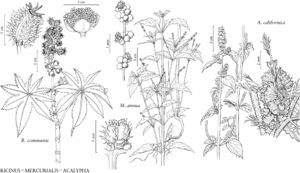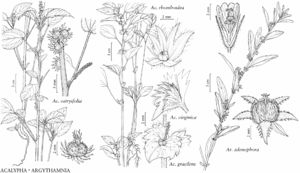Acalypha
Sp. Pl. 2: 1003. 1753.
Herb or shrubs [trees], annual or perennial, unarmed, monoecious or dioecious; hairs unbranched [stellate], sometimes glandular, or absent; latex absent. Leaves persistent or drought-deciduous, alternate, simple; stipules present, persistent or deciduous; petiole present, glands absent or present at apex, adaxial, inconspicuous [conspicuous]; blade unlobed, margins deeply serrate or crenate to subentire, laminar glands absent; venation palmate at base, pinnate distally [pinnate]. Inflorescences unisexual or bisexual (pistillate flowers proximal, staminate distal [staminate proximal, pistillate distal]), axillary or terminal, spikelike [paniclelike] thyrses; allomorphic pistillate flowers sometimes present; bracts subtending pistillate flowers enlarging in fruit [remaining minute]; glands subtending bracts 0. Pedicels: staminate present, pistillate absent [present], allomorphic present or absent. Staminate flowers: sepals 4, not petaloid, 1–2 [–3] mm, valvate, distinct [connate]; petals 0; nectary absent; stamens 4–8, distinct; anthers elongated and twisted at maturity; pistillode absent. Pistillate flowers: sepals 3 [or 5], distinct [connate]; petals 0; nectary absent; pistil (1–) 3-carpellate; styles (1–) 3, distinct or connate basally, usually multifid or laciniate, rarely 2-fid or unbranched, branches threadlike. Fruits capsules, allomorphic fruits achenes or schizocarps. Seeds ellipsoid to subglobose; caruncle present, sometimes rudimentary. x = 10.
Distribution
North America, Mexico, West Indies, Central America, South America, Asia, Africa, Indian Ocean Islands, Pacific Islands, Australia, in Europe, primarily tropical and subtropical regions, reaching temperate regions in eastern North America and eastern Asia
Discussion
Species ca. 450 (18 in the flora).
Some species of Acalypha are cultivated as ornamentals, notably A. herzogiana Pax & K. Hoffmann, A. hispida Burman f., and A. wilkesiana; the last has become naturalized in Florida. Acalypha herzogiana has escaped locally on Dauphin Island, Alabama (H. Horne, pers. comm.). It may escape locally elsewhere but might not become naturalized in the flora area, because the cultivated form is sterile, although pieces of the plant root readily if they are spread. It is an herbaceous perennial readily recognized by its erect, feathery, red spikes of sterile pistillate flowers (V. W. Steinmann and G. A. Levin 2011).
Acalypha mexicana Müller Arg. [A. indica Linnaeus var. mexicana (Müller Arg.) Pax & K. Hoffmann], native from central Mexico to Guatemala, was collected twice early in the twentieth century in southeastern Arizona but has not been collected there since and presumably did not become established. It will key here to A. australis; A. mexicana differs in having pistillate bracts that are 10 mm and eglandular (versus 10–15 mm and glandular) and allomorphic flowers that are common, long-pedicelled, and 1-carpellate (versus rare, sessile, and 2-carpellate).
Some Acalypha species, including about half of those in the flora area, produce allomorphic pistillate flowers (A. Radcliffe-Smith 1973). These flowers may be mixed with normal pistillate or staminate flowers or be terminal on the inflorescence. Their pistils generally have fewer carpels than normal pistillate flowers of the same species, bear sub-basal rather than terminal styles, and develop into nutlets or schizocarps, frequently bearing bristles or variously ornamented outgrowths that presumably facilitate dispersal. Unlike normal pistillate flowers, allomorphic flowers frequently lack bracts and are borne on elongate pedicels. Characters of these flowers generally are species-specific and useful for identification (Radcliffe-Smith).
The bracts subtending normal pistillate flowers of most Acalypha species, including all in the flora area, enlarge as the fruits develop. Measurements for these bracts, referred to here as pistillate bracts, and the pistillate portion of the inflorescences given in the key and descriptions are post-anthesis, after the bracts have completed most or all of their growth.
Seed descriptions pertain to those from normal pistillate flowers.
The sequence of species below starts with shrubs (species 1 and 2), followed by subshrubs and perennial herbs (species 3 to 6), and concludes with annual herbs (species 7 to 18). Within each growth form, similar species are grouped together.
Selected References
Lower Taxa
Key
| 1 | Shrubs. | > 2 |
| 2 | Leaf blades 1–5 cm; stems stipitate-glandular; plants 5–10 dm; Arizona, California. | Acalypha californica |
| 2 | Leaf blades 9–20 cm; stems not glandular; plants 20–50 dm; Florida. | Acalypha wilkesiana |
| 1 | Herbs or subshrubs. | > 3 |
| 3 | Pistillate bract lobes linear or proximally deltate with linear tips. | > 4 |
| 4 | Pistillate bracts densely crowded (inflorescence axis not or sparingly visible between bracts), abaxial surfaces long-hirsute (nonglandular hairs to 2 mm), lobes proximally deltate with linear tips, smooth. | > 5 |
| 5 | Stems, petioles, and peduncles stipitate-glandular; pistillate inflorescences terminal; styles unbranched or rarely 2-fid. | Acalypha alopecuroidea |
| 5 | Stems, petioles, and peduncles not stipitate-glandular; pistillate (and bisexual) inflorescences axillary; styles multifid or laciniate. | Acalypha arvensis |
| 4 | Pistillate bracts loosely arranged (inflorescence axis visible between bracts), abaxial surfaces glabrous or pubescent (nonglandular hairs to 0.3 mm, glandular hairs may be longer), lobes linear, muricate. | > 6 |
| 6 | Leaf bases cordate; pistillate bracts pubescent and stipitate-glandular; capsules spiny; seeds tuberculate. | Acalypha ostryifolia |
| 6 | Leaf bases obtuse to rounded or truncate; pistillate bracts glabrous; capsules smooth; seeds minutely pitted. | Acalypha setosa |
| 3 | Pistillate bract lobes deltate (without linear tips), triangular, attenuate, narrowly oblong, lanceolate, spatulate, or rounded. | > 7 |
| 7 | Inflorescences (all or some) terminal. | > 8 |
| 8 | Stems erect; leaf blades 2–6 cm. | > 9 |
| 9 | Inflorescences usually bisexual (rarely staminate portion replaced by allomorphic pistillate flowers), all terminal; petioles 0.2–1 cm; allomorphic pistillate flowers rare, pedicels 3–5 mm, without bracts. | Acalypha phleoides |
| 9 | Inflorescences unisexual, pistillate terminal (sometimes on short lateral branches, appearing axillary), staminate axillary; petioles 1–4 cm; allomorphic pistillate flowers common, pedicels rudimentary, bracts like those of normal pistillate flowers. | Acalypha neomexicana |
| 8 | Stems prostrate to ascending; leaf blades 0.3–2.5 cm. | > 10 |
| 10 | Petioles 0.1–0.5 cm, less than 1/3 leaf blade length; inflorescences all bisexual and terminal; Florida. | Acalypha chamaedrifolia |
| 10 | Petioles 0.4–2.5 cm, more than 2/3 leaf blade length; inflorescences unisexual or bisexual, terminal and axillary; Texas. | > 11 |
| 11 | Leaf blade margins shallowly crenate; pistillate bract lobes 1/4 bract length. | Acalypha monostachya |
| 11 | Leaf blade margins deeply crenate; pistillate bract lobes 1/2 bract length. | Acalypha radians |
| 7 | Inflorescences all axillary. | > 12 |
| 12 | Pistillate bracts 4–5 mm; styles unbranched. | Acalypha poiretii |
| 12 | Pistillate bracts 6–15(–20) mm; styles multifid or laciniate. | > 13 |
| 13 | Pistillate bract lobes rounded, 1/20 bract length. | Acalypha australis |
| 13 | Pistillate bract lobes deltate, triangular, lanceolate or narrowly oblong, 1/10–3/4 bract length. | > 14 |
| 14 | Leaf blades linear, linear-lanceolate, or oblong-lanceolate; pistillate bracts sessile-glandular, lobes deltate, 1/10–1/4 bract length. | > 15 |
| 15 | Pistils 3-carpellate. | Acalypha gracilens |
| 15 | Pistils 1-carpellate. | Acalypha monococca |
| 14 | Leaf blades broadly lanceolate to ovate or rhombic; pistillate bracts not sessile-glandular (sometimes stipitate-glandular), lobes triangular to lanceolate or narrowly oblong, 1/4–3/4 bract length. | > 16 |
| 16 | Pistillate bract abaxial surfaces hirsute (sometimes also stipitate-glandular), lobes (9–)10–14(–16), 1/4–1/2 bract length; stems usually hirsute. | Acalypha virginica |
| 16 | Pistillate bract abaxial surfaces sparsely pubescent (usually also stipitate-glandular), lobes (5–)7–9(–11), 1/3–3/4 bract length; stems usually pubescent or glabrate, rarely hirsute. | > 17 |
| 17 | Pistils (normal flowers) 2-carpellate; seeds 2.4–3.2 mm. | Acalypha deamii |
| 17 | Pistils (normal flowers) 3-carpellate; seeds (1.2–)1.5–1.7(–2) mm. | Acalypha rhomboidea |
"elongated" is not a number."connate" is not a number. "distinct" is not a number.

